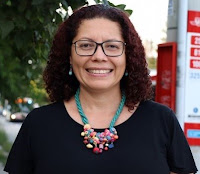By Michael Holloway
When Transportation Division engineers model traffic flows on their computers using massive data-bases, they model traffic across the city that moves as many cars as possible.
While that may be appropriate in the areas of the City outside the old City of Toronto that were built for the most part post-world-war-two, and were designed mainly with car transportation in mind (long distances to destinations; cul-de-sac neighbourhoods surrounded by 4 and 6 lane major arterials), the old city is built differently - a
grid of local roads every 100 metres with 4-lane major arterials and collectors every 500 metres); in this precinct, only moving lots of cars is not appropriate.
The big difference is two-fold:
- The suburban road network is designed to accommodate flows via major arterial roads and 400 series highways to the core - a massive employment district;
- The core road network is built to manage that massive influx and out-routing of employment and delivery traffic flow.
What makes the old Toronto special is that it is the focus of so much destination travel - and the road network focuses traffic into an increasingly congested road network the closer you get to the downtown core. Plus all the people who live in the old city (markedly higher population density than the suburbs) also use the road network to travel much shorter distances to and from jobs in the core.
Ask any long-commute driver where the road network becomes intolerably congested and they will reply about a spot generally marking a point somewhere near the border between the new city and the old city of Toronto.
It's a function of the road network and destination desires.
To reduce congestion on these old city arterial roadways we need to facilitate mass transit and active transportation alternatives.
Street car right-of-ways are a blight on the urban landscape - they divide neighbourhoods much like 6-lane arterials do. They are - in this author's opinion - a reaction to car congestion, not a solution to it. The trick of it is to reduce the number of cars on the roadway at peak, and that will free up space such that mass public transit can flow efficiently on our roadways without dedicated tramways.
Making every major arterial in Toronto and East York a complete street has the possibility of reducing the numbers of cars on these roadways from local sources by as much as 70%.
Make Driving Great Again?
And we do this NOT for the Bike Lobby - but to make on-street mass public transit flow smoothly. By reducing the number of cars on the roadway through complete street infrastructure changes - we are thus making drivers into both cycle commuters, and mass transit commuters; and we're changing individuals who
must drive from deadly, raging scofflaws into smooth-flow happy commuters - which makes the city safer and happier for everyone.
Complete Streets Infrastructure Every Time Curbs are Renewed
Transportation Division manages must develop data modeling that reflects this reality - and design new (but already designed in many, many examples from around the globe) street configurations which reflect this special character of Toronto & East York; and politicians must change a slew of policies across Divisions that makes sure our already almost 20-years old 'complete streets policy' actually creates complete streets every time ROW's are renewed.
Recent examples where complete streets were not installed when curbs were renewed:
2012 - Leslie Street south of Queen
2016 - Broadview Avenue north of Danforth
2017 - Kingston Road, Queen to Victoria Park
2018 - Donlands Avenue, Danforth to O'Connor
-----
Image via Wikimedia Commons -
https://upload.wikimedia.org/wikipedia/commons/a/a6/Old_Toronto_locator.png
Michael Holloway
Ward 30 Bikes
Outreach Coordinator
P.S. The active transportation lobby needs a contact within Transportation Division; an engineer who can share traffic modelling of (for example) the flows described above
(thinking Not sharing massive (propitiatory) files, but using a mobile to shoot onscreen modelling which your colleagues or yourself have built as part of your daily work which may be of some use to progressive transportation advocates).
^mh











